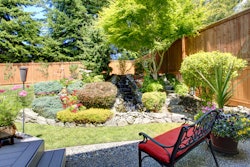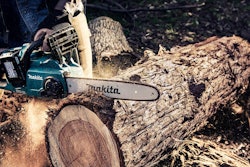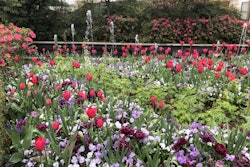 Photo: Plemons Lawn & Landscape
Photo: Plemons Lawn & LandscapeBy now, many of your customers have probably already inquired about spring cleanup services for their lawn, but there might be a few new customers or some that are just late to the party who are asking about it now.
Offering spring cleanup services can be an excellent way to get new customers warmed up to your company and all you can offer them in the future because it doesn’t require them to commit to a large, expensive project right out of the gate, and it gives them the chance to meet your crew and see what an efficient and beautiful job they can do.
Cleanup services can be something as simple as clearing out flower beds or picking up dead leaves and branches, but even a task this simple can make a world of difference for your customer.
If customers are asking why these cleanup services are necessary, whether some are more important than others and what the ramifications could be if these services are passed over, take a look at what other green industry experts advise recommending to skeptical clients.
Why it’s important
As you know, not every customer will automatically be on board with your suggestions when it comes to lawn care, so it might require you to educate them a bit on why exactly these cleanup services are important to the health and beauty of their lawn.
Richey Plemons, owner of Plemons Lawn & Landscape in Chatsworth, Georgia, has found that overall, his customers are pretty evenly split between going all-in on cleanup services and only wanting what’s absolutely necessary to the survival of the lawn.
The method he’s found most successful for communicating the importance of cleanup services is to take time to sit down with the customer face-to-face and create a plan together for the whole upcoming year.
“We’re trying to get them to understand that if we don’t get this debris up, you’re going to have a patchy lawn and bare spots,” says Plemons. “Let’s get all (that debris) up, that way it starts growing thick and really nice.”
For customers who actively choose not to participate in cleanup services, Plemons recommends sitting down with them to discuss what the end result will be for their lawns if these services are ignored.
For landscapers in the South, Plemons says to always remind customers of the dangers of creeping vines like kudzu and others that could potentially take over the landscape if left to their own devices.
“If they don’t keep their beds maintained and keep this stuff out of the beds, they can start losing plant material pretty quick,” says Plemons. “In the lawn itself, if you don’t get the debris up and get it cleaned up so the grass can start getting some sunlight and rain, you start getting brown spots, dead areas and really thin grass. Every lawn’s a little different; it’s its own separate challenge.”
Plemons also recommends getting together with the customer to walk their property with them to really show them up close what needs to be done in the area, as well as point out any bad areas that might be a result of not having these services performed in years prior.
If there are certain areas that have gone into disrepair due to a lack of cleanup, Plemons says to describe to the customer in detail what kind of time, work and money will have to go into repairing the lawn if it’s left unkempt for another year.
“Show them what happened because last year they didn’t want (cleanup) done,” he says. “We (could have prevented) that, but now this has to be repaired and it will cost more than what it would have originally been to just have it done the right way the first time. Show them that this is the price to maintain it and prevent it from having all of that, and this is the price of what it’s going to cost now to fix this area of the lawn that was neglected last year.”
Types of services
While there may be a slew of cleanup services offered by different landscape professionals around the country, the following services are some of the most beneficial and important ones that shouldn’t be ignored.
Aeration and seeding
Plemons says that he does have his fair share of customers who enjoy working in their flower beds or ones who are on a tighter budget, so not every aspect of his company’s spring services will come into play.
 Photo: Plemons Lawn & Landscape
Photo: Plemons Lawn & LandscapeWhen asked which service he considered the most important, his recommendation was aeration.
“A good aeration in the springtime gets some air into those roots,” he says. “Every lawn will benefit from a good aeration. If you can get some space in there and get the air molecules into those root systems, it’s going to be a thicker, richer, darker green lawn.”
Even if your customers don’t want seeding services along with the aeration, or they have certain grass types that make it difficult to overseed, Plemons says having that air in the soil will increase seed-soil contact and improve germination rates.
If your customers are dealing with soil compaction or are in an area with clay soils in their landscape, Plemons says that good aeration can also help alleviate these issues and improve water and nutrient movement in the soil. It’s recommended to aerate lawns that experience heavy foot traffic throughout the year or have clay soils twice annually. If your customer’s lawn has well-drained soils or has very little compactions, one aeration treatment a year should suffice.
The best time to aerate is when the soil is moist, which is generally about one or two days after it rains. It’s also best to perform aeration services when the lawn is actively growing, as this allows it to recover from any damage experienced during the process. Cool-season grasses should be aerated from late March to the end of May, and warm-season grasses should be aerated in late May to late August.
Seeding the lawn pairs well with aeration services, and while the best time to perform this service is in the fall, if your customer’s lawn has been neglected, has poor turf density because of winter damage, pest damage or drought damage, it can be done in the spring.
If you want it to be successful in the spring, it needs to be done as early as possible to help the turfgrass compete with crabgrass. The seed to soil contact will be important, and areas that are seeded will need to be kept very moist while it establishes.
For the first three or four weeks after seeding, be sure to mow on a lower setting to allow sunlight to reach the new seeds.
Dethatching and mulching
While it’s true that thatch isn’t necessarily a bad thing to have in the landscape, it can ultimately lead to other issues if too much accumulates, as a thick enough layer of it can keep water and air from reaching the soil. A thicker layer of thatch can also harbor pests and diseases.
Check to see if thatch is over one inch high, and once it has reached this height, it can be removed with a rake, dethatching mower or vertical mower. This service can also remove a fair amount of turf in the process, depending on how much thatch is present.
Since dethatching can be a stressful process for turf, it should be performed when the grass is actively growing and the soil is fairly moist. For cool-season grasses, early spring will be the best time, and after a couple of mowings in late spring through early summer will be the best time for warm-season grasses.
Another simple service that can be offered is mulching. Not only does mulching give the landscape a fresh, new look, it also helps maintain the temperature of the soil and conserves water.
To see more from Plemons and the equipment he uses in his cleanup services, check out his YouTube channel.










